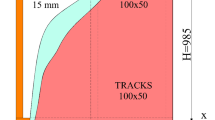Abstract
Limiting the fire spread through lightweight framed construction is a well-established method of providing fire safety in building design. The design objective is for walls to provide fire resistance for a certain period to satisfy fire safety requirements. This paper describes a model for predicting the fire resistance of a non-loadbearing or loadbearing timber framed wall subjected to either a standard fire resistance test or realistic fire conditions. Prediction of the fire resistance uses finite difference techniques for heat conduction within linings and for convection and radiation on the boundaries and cavity. An algorithm for the charring of timber is included to determine a structural failure condition for the studs.
Similar content being viewed by others
References
ISO 834, “Fire Resistance Tests, Elements of Construction,” International Standards Organization, Geneva, Switzerland, 1975.
R. Feasey, “Post-Flashover Design Fires,” Fire Engineering Research Report 99/6, University of Canterbury, Christchurch, New Zealand, 1999.
P.C.R. Collier, “Design of Loadbearing Light Timber Framed Walls for Fire Resistance: Part 1,” Building Research Association of New Zealand, Study Report No. 36, Judgeford, Wellington, 1991.
P.C.R. Collier, “Design of Light Timber Framed Walls and Floors for Fire Resistance,” Building Research Association of New Zealand Technical Recommendation No. 9, Judgeford, Wellington, 1991.
P.C.R. Collier, “Design of Loadbearing Light Timber Framed Walls for Fire Resistance: Part 2,” Building Research Association of New Zealand, Study Report No. 42, Judgeford, Wellington, 1992.
P.C.R. Collier, “Software for the Design of Light Timber Frame Construction for Fire Resistance—A User's Guide,” version 1.0, Building Research Association of New Zealand, Judgeford, Wellington, 1996.
J.T. Gerlich, “Design of Loadbearing Light Steel Frame Walls for Fire Resistance,” Fire Engineering Research Report 95/3, University of Canterbury, Christchurch, New Zealand, 1995.
J.T. Gerlich, P.C.R. Collier, and A.H. Buchanan, “Design of Light Steel Framed Walls for Fire Resistance,” Fire and Materials, vol. 20, no.2, 1996, pp. 79–96.
P.C.R. Collier, “A Model for Predicting the Fire Resisting Performance of Small-Scale Cavity Walls in Realistic Fires,” Fire Technology, vol. 32, no.2, 1996, pp. 120–136.
P.C.R. Collier, “Fire Resistance of Lightweight Construction,” Fire Engineering Research Report 00/2, University of Canterbury, Christchurch, New Zealand, 2000.
C.A. Wade, “BRANZFIRE—Technical Reference Guide,” Building Research Association of New Zealand, Judgeford, Wellington, 2000.
B.W. Gammon, “Reliability Analysis of Wood Frame Wall Assemblies Exposed to Fire,” University Microfilms Dissertations Information Service, University of California, Berkley, 1987.
J.J. Fuller, R.J. Leichti, and R.H. White, “Temperature Distribution in a Nailed Gypsum-Stud Joint Exposed to Fire,” Fire and Materials, vol. 16, 1992, pp. 95–99.
G.C. Thomas, “Fire Resistance of Light Timber Framed Walls and Floors,” Fire Engineering Research Report 97/7, University of Canterbury, Christchurch, New Zealand, 1997.
C.P. Butler, “Noteson Charring Ratesin Wood,” Fire Research Station, Note FR 896, Borehamwood, United Kingdom, 1971.
C.L. Tien, K.Y. Lee, and A.J. Stretton, “Radiation Heat Transfer,” in The SFPE Handbook of Fire Protection Engineering, Boston: Society of Fire Protection Engineers/National Fire Protection Association, 1995, Section 1 Chapter 4.
E. Mikkola, “Charring of Wood,” Espo 1990, Valtion teknillinen tutkimuskeskus, Tutkimuksia-Statens tekniska forskningscentral, Forskningsrapporter—Technical Research Centre of Finland, Research Report 689, 1990, 35 pp.
ISO 9705, “Full Scale Test for Surface Products, International Standards Organisation, Geneva, Switzerland, 1993.
M. Law, “Prediction of Fire Resistance,” in Proceedings, Symposium No. 5, Fire-Resistance Requirements for Buildings—A New Approach, Joint Fire Research Organisation: London: HM Stationery Office, 1973.
V. Babaraukas, “Burning Rates,” in The SFPE Handbook of Fire Protection Engineering, Boston: Society of Fire Protection Engineers/National Fire Protection Association, 1995, Section 3 Chapter 1.
D.H. Walton, and P.H. Thomas, “Estimating Temperatures in Compartment Fires,” in The SFPE Handbook of Fire Protection Engineering, Boston: Society of Fire Protection Engineers/ National Fire Protection Association, 1995, Section 3 Chapter 6.
Author information
Authors and Affiliations
Rights and permissions
About this article
Cite this article
Collier, P., Buchanan, A. Fire Resistance of Lightweight Timber Framed Walls. Fire Technology 38, 125–145 (2002). https://doi.org/10.1023/A:1014459216939
Issue Date:
DOI: https://doi.org/10.1023/A:1014459216939




